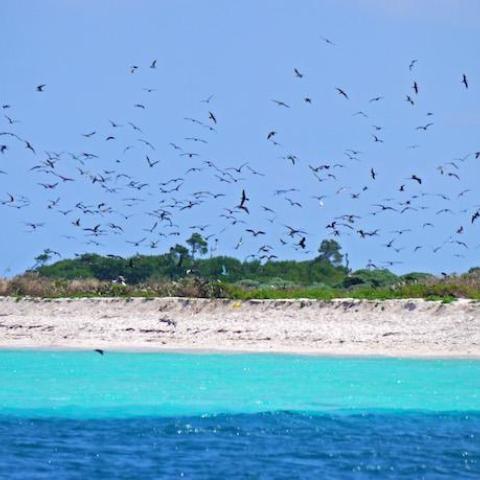
Repairs are getting underway on the Tortugas Harbor Lighthouse at Dry Tortugas National Park/NPS, D. Diaz
After 144 years, the deterioating Tortugas Harbor Lighthouse at Dry Tortugas National Park is getting a much-need rehabilitation expected to keep it standing for another century. This past Monday marked the start of a $4.5 million project to restore and preserve the lighthouse.
“The Tortugas Harbor Lighthouse is an iconic symbol of Dry Tortugas National Park. While partial repairs to the lighthouse have occurred over the past 40 years, it has never received this kind of comprehensive preservation,” said South Florida Parks and Preserve Superintendent Pedro Ramos. “The National Park Service is committed to preserving this important piece of our American story.”
The iron-plated lighthouse has been exposed to the elements and the effects of salty ocean air since its construction in 1876. Over time, the iron has corroded leading to significant deterioration in many areas, particularly around its base.
“The Preserve Tortugas Harbor Lighthouse project will use money generated from park entrance fees to ensure that future generations will be able to experience this part of our national heritage,” said park Manager Glenn Simpson. “The National Park Service has overseen decades of various repairs, including stabilizing and strengthening, and we’re excited to finally see this comprehensive restoration work being done.”
The three-phase Preserve Tortugas Harbor Lighthouse Project is expected to take about a year and visitors will be able to watch the first phase over the coming month.
- Phase I: A restoration crew from Stone and Lime., Inc. will disassemble the 37-foot iron lighthouse structure piece-by-piece and transport the components from Garden Key to mainland Florida.
- Phase II: Metal conservation and repair of the lighthouse structure at the conservation facilities of subcontractor Robinson Iron in Alexander City, Ala.
- Phase III: Reassembly of the lighthouse in its original location. Subcontractor Jablonski Building Conservation will oversee the historic preservation requirements of the project.
Located at the meeting point of the Atlantic Ocean, Gulf of Mexico, and the Caribbean Sea, the Dry Tortugas have a rich maritime heritage. Shallow sand banks and coral reefs made nautical aids to navigation, like lighthouses, critical for safe passage around the islands. Even so, many ships succumbed to these tricky waters and contributed to the large concentration of shipwrecks in the park. Although deactivated in 1921, the Tortugas Harbor Lighthouse and other historical aids to navigation are important to telling the histories of places like Dry Tortugas National Park.
Garden Key Light
The Garden Key light was one of three lighthouses slated to be constructed in the Florida Straits in 1824 by the United States Congress. By 1826, the 65-foot tall light was completed on the eastern shore of Garden Key. However, a serious flaw was soon discovered in the lighthouse’s design. The iron door of the lighthouse, which housed the lantern, created a gap in visibility for vessels approaching from the east. The door was soon removed, but problems continued with the lamp itself.
The lighthouse keeper petitioned congress that two new lighthouses be built on each end of the shoals to replace the Garden Key light because of the continued number of shipwrecks and general inadequacy of light. Instead, congress sent inspectors to survey the Garden Key light in 1836. By 1838, new plate glass and lanterns were installed upon the recommendations of the inspectors. However, more technical issues ensued and the new additions were shattered by 1839.
Shipwrecks and navigation issues increased until 1858 when a more adequate lighthouse, the Dry Tortugas Light (now known as the Loggerhead light), was constructed on Loggerhead Key. The Garden Key light was outfitted with a news lens and 21-inch reflectors and renamed Tortugas Harbor Light. The Tortugas Harbor Light sustained serious damage after hurricanes in 1873 and 1875. As a result, the Lighthouse service advised that a new lighthouse to be constructed. By the end of 1876 the new lighthouse was finished on one of the bastions of Fort Jefferson.



 Support Essential Coverage of Essential Places
Support Essential Coverage of Essential Places







Comments
my son is working on this restoration